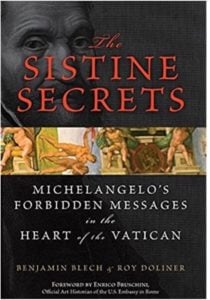The largest Jewish-themed fresco painting in the entire world, over 10,000 square feet is Michelangelo’s ceiling in the Sistine Chapel. The first two Torah sections of the book of Genesis–event by event. There is not one single image from Christian tradition.
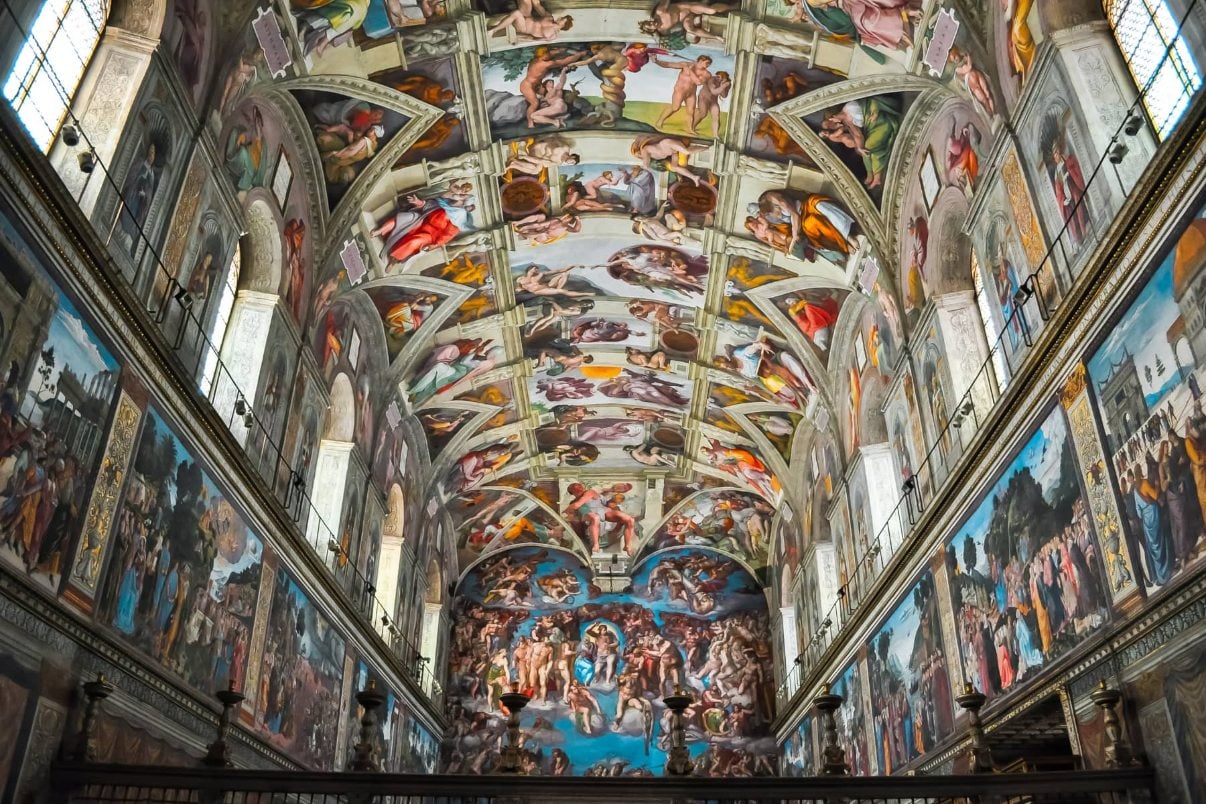
The Sistine Chapel
The Sistine Chapel was designed to be a copy of the holy Jewish Temple in Jerusalem built by King Solomon.
According to the prophet Samuel, the exact measurements of the Heichel, the long, rectangular back section of the first holy Temple completed by King Solomon and his architect, King Hiram of Tyre, in 930 B.C.E., are 134.28 feet long by 43.99 feet wide by 67.91 feet high. And these are the exact dimensions used for the construction of the Sistine Chapel.
It is even less known by most visitors to the Sistine Chapel that, in keeping with the intent to simulate the sacred site existing in ancient Jerusalem, the sanctuary was built on two levels. The Western half, containing the altar and the private area for the Pope and his court, is about six inches higher than the Eastern half, originally intended for the common laymen (people). This elevated section corresponds to the farthest recesses of the original holy Temple – the Kodesh Kodoshim, the Holy of Holies – where only the high priest could enter, only once a year, on Yom Kippur, the Day of Atonement.
To show exactly where the Porochet, the curtain separating the two, would have been in the Temple of Jerusalem, a grand partition grill of white marble was commissioned, with seven marble flames on top, to correspond to the holy menorah in the Jewish sanctuary in biblical times.
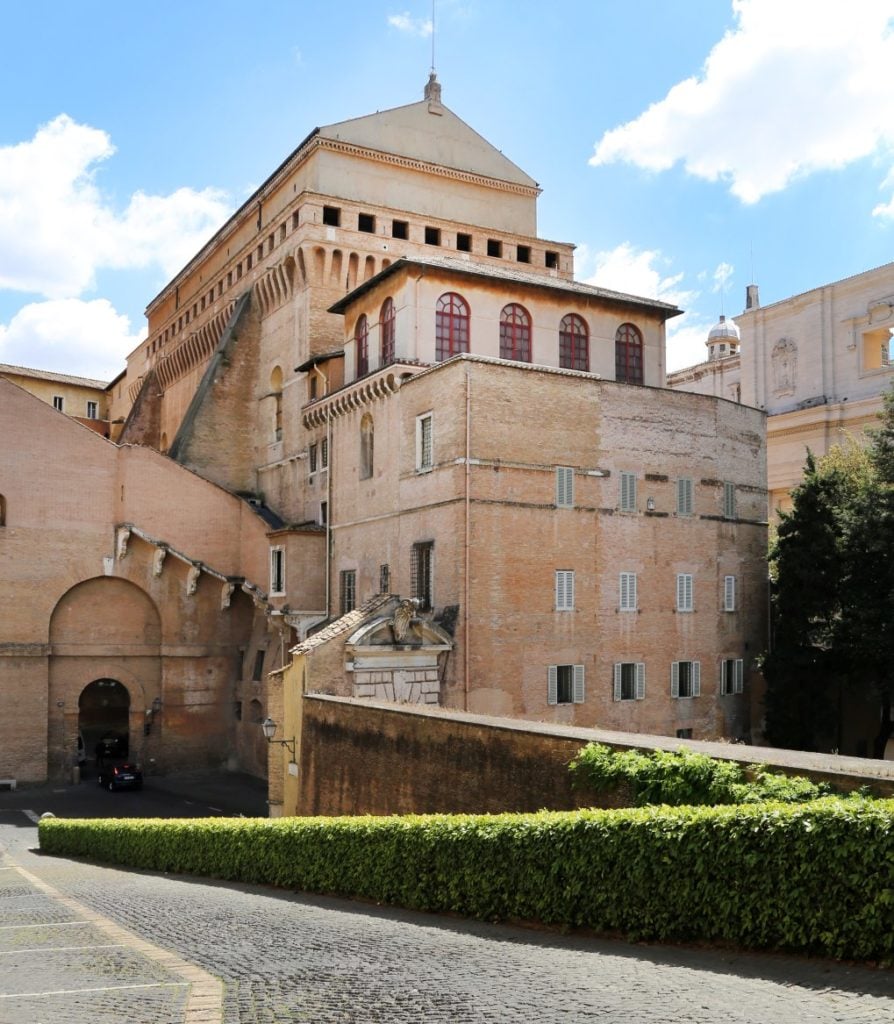
Sailko, CC BY 3.0 <https://creativecommons.org/licenses/by/3.0>, via Wikimedia Commons
There are seven Hebrew prophets and five sibyls (originating from the Greek work Sibylla, which means prophetess, but originally derives from the earlier Babylonian/Aramaic sabba-il, an ancient one of God) surrounding the nine scenes from the Torah, gazing down upon us from the inner sanctum of King Solomon’s Temple, now reproduced and reified as the Sistine Chapel.
A brief overview of the Seven Prophets from the “The Sistine Secrets“(Harper Collins 2008).
The prophets give evidence that Christianity developed from Judaism. More importantly, they demonstrate how the artist Michelangelo di Lodovico Buonarroti Simoni, better known as Michelangelo (1475-1564), had great knowledge and respect for Jewish tradition. The selection of the specific seven prophets is another multilayered way of viewing the universe, as alluded to in the Talmud and the Kabbala. The number seven has symbolic significance, such as the seven days of creation. However, in the Kabbala, not only the material universe but also Reality itself was brought into being during these seven days.
Yet, another significance to the number seven is its connection with the seven lights of the seven-branched candelabra (menorah) was inside the Holy Temple of Jerusalem. Michelangelo specifically chose the following prophets that represent the Seven Middot (seven characteristics of the seven s’firot or spheres on the Kabbalistic Tree of Life. The Seven Middot are also considered to be seven spiritual steps to bring us closer to God.
Zechariah represents the attribute of Malchut – empire, kingdom. His name means “God has remembered” and his mission emphasizes all the empires in the material world that sought to wipe out the Jewish religion. God remembered and redeemed the Jewish people, as illustrated in all four corner panel frescoes.
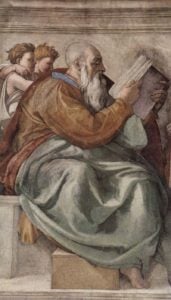
Joel represents the attribute of Yesod — foundation. His name means “God is God“. It is the foundation of spirituality and religion, and the basic link between heaven and earth
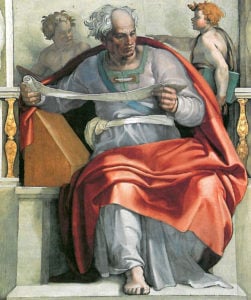
Isaiah represents the attribute of Hod — glory, splendor. His name means that “God is my salvation.” He warned of the terrible defeats and sufferings that the Jews would have to endure, but also encouraged them to hold on to their faith and to keep one’s word to God, no matter what.
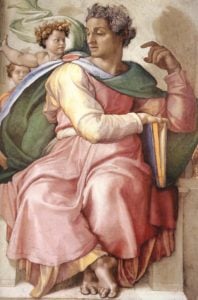
Ezekiel represents the attribute of Netzach — victory, eternity. His name means “God is my strength.” He told the suffering Jews that perseverance would win back Jerusalem and build the Third Holy Temple there.
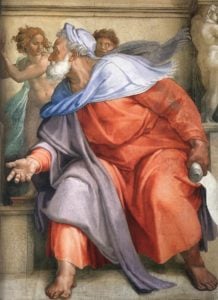
Daniel represents the attribute of Tiferet — beauty. His name means “God has judged”. This is the central s’firah of the Seven Middot and of the Tree of Life. The prophet Daniel represents balance, the unifying and harmonizing of future redemption to both Jews and Christians.
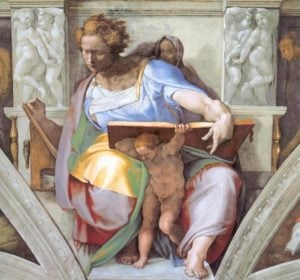
Jeremiah represents the attribute of G’vurah – strength, power. His name means “God has exalted me”. He was the harshest orator of all the prophets., candigly pointing out all the corruption he found in the priesthood, as well as in national leaders.
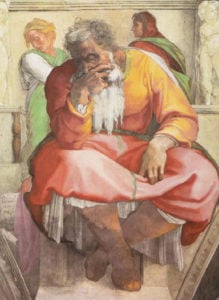
Jonah represents the attribute of Chessed – mercy, compassion, loving-kindness. His name means “God will answer”. Jonah is given the command to preach repentance to the corrupt pagan city of Nineveh against his own wishes. The very last words of his book are from God, telling Jonah why it was important to have mercy on this vast city and its people, regardless of they were gentile or Jewish.
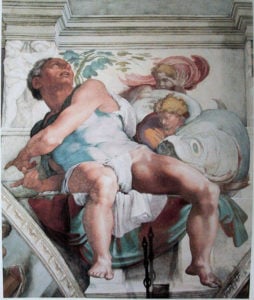
Moreover, the prophets were charged with telling the Jews the Who (God) was giving the orders, Why God was doing it, the How, When, Where, and Why was telling them to achieve these goals, even if the people did not understand. The prophets were the mouthpiece of God, and this is what Michelangelo depicted as the Sistine ceiling.
The Five Sibyls
Sibyls are not the same as Jewish prophets. A sibyl, or oracle, will respond only to a question asked of her, whereas a prophet/prophetess is a messenger (mouthpiece) for God, speaking, blessing, cursing, and predicting the future — without human influence. The location of each of the five sibyls in the ceiling is of great significance and helps us understand the four corner spandrels (fan-shaped panels) in the chapel’s corners representing the four major exiles of the Jews according to the book of Daniel: Egypt, Babylon, Persia, and Greece. Michelangelo brilliantly juxtaposed each sibyl nearest the exile it represents.
The Delphic Sibyl represents Greece’s dominance; she is next to the Judith-and-Holofernes corner panel, which deals with the Hanukkah story in the book of Maccabees, recalling the freedom of the Jewish people from Hellenistic (Greek) dominance.
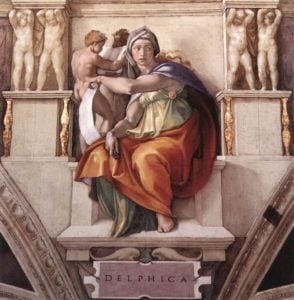
The Libyan Sibyl represents Egypt, is next to the corner panel of Moses’s copper serpent saving the Jews who had been redeemed from Egypt.
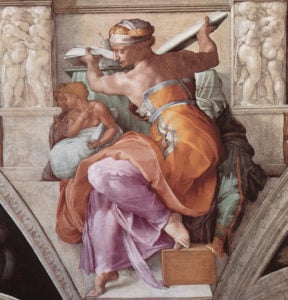
The Persian Sibyl is next to the corner panel dealing with the story of Esther, who saves the Jews of Persia from the genocidal Haman.
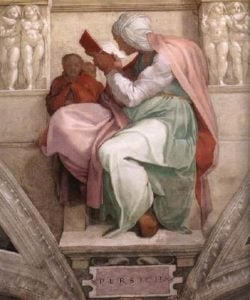
The Erythraen Sibyl, middle Eastern sibyl, is next to the corner panel which depicts the Jewish hero David defeating Goliath, the Philistine Giant.
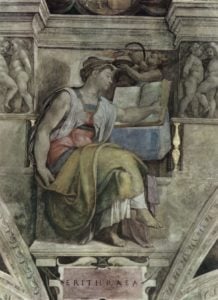
During the lifetime of Michelangelo, the Jews were under the control of the Church. Therefore, the Cumaean Sibyl represents Rome.
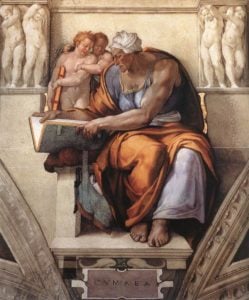
Scenes from the Torah
The nine Torah scenes are undoubtedly the most famous part of the entire Sistine Chapel. Here are a few fascinating examples from The Sistine Secrets that discuss in great depth Michelangelo and his Sistine Chapel.
1) The forbidden fruit in the Garden of Eden is an apple, in Christianity. However, according to the Talmud, it is a fig. In the middle of the Pope’s ceiling, Michelangelo paints a fig tree.
2) Jonah is swallowed by a whale. However, in the Jewish original and in Midrash, is it a giant fish called Leviathan. Michelangelo depicts a giant fish, not a whale.
3) Noah’s ark is a giant boat. However, in the Talmud and Midrash, it is a giant floating box. Michelangelo’s version of the ark is the only one in the Renaissance where it is a giant floating box.
4) Eve is made out of Adam’s rib. However, according to the Talmud and Midrash, she is made from his side. Michelangelo depicts Eve emerging from Adam’s side, not from his rib.
5) According to the Midrash, the serpent in the Garden of Eden had arms and legs.
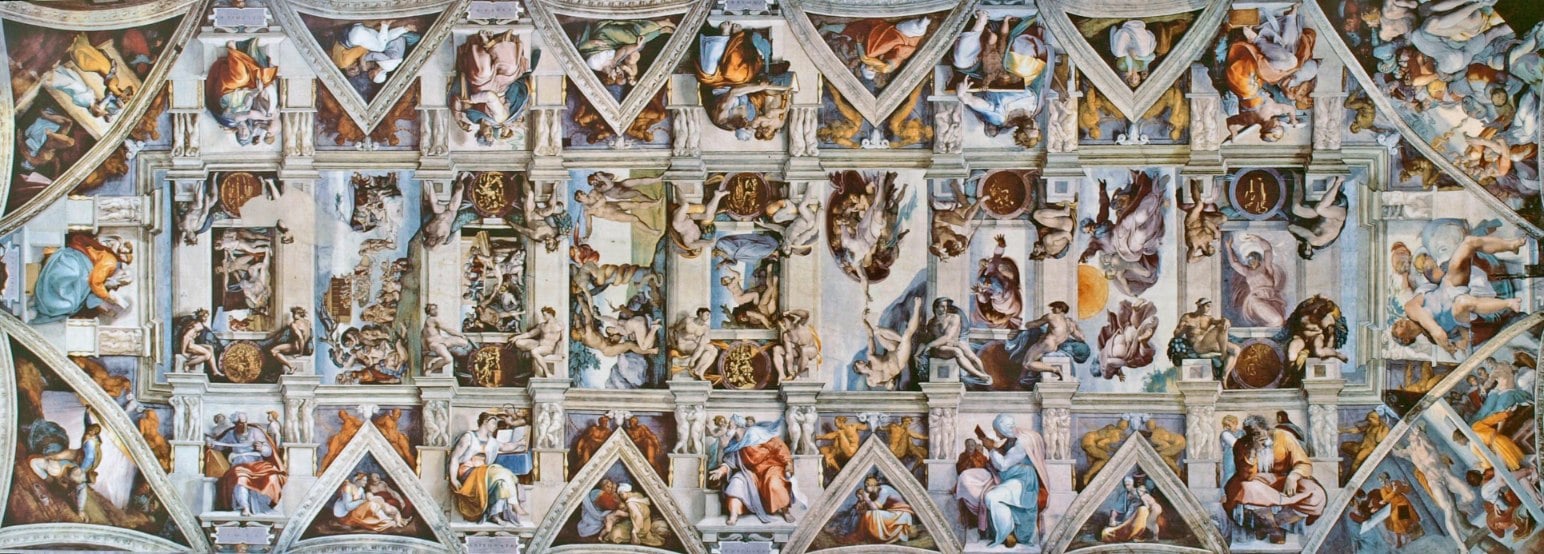
Michelangelo, CC BY-SA 3.0 <https://creativecommons.org/licenses/by-sa/3.0>, via Wikimedia Commons
The Kabbala of the Universal Last Judgement
The Last Judgement represents the end of the world and the eternal judgment of God of the saved and the damned. However, Michelangelo depicts the same balance of the universe that he concealed in his ceiling. According to the Kabbala, there is a central point in the universe — the ladder of Jacob. The passage can be found in Genesis 28:12, Jacob dreams of the divine ladder, by which the angels descend to earth and ascend to heaven. Therefore, this is the link between heaven and earth, humanity and angels, and the material and spiritual worlds.
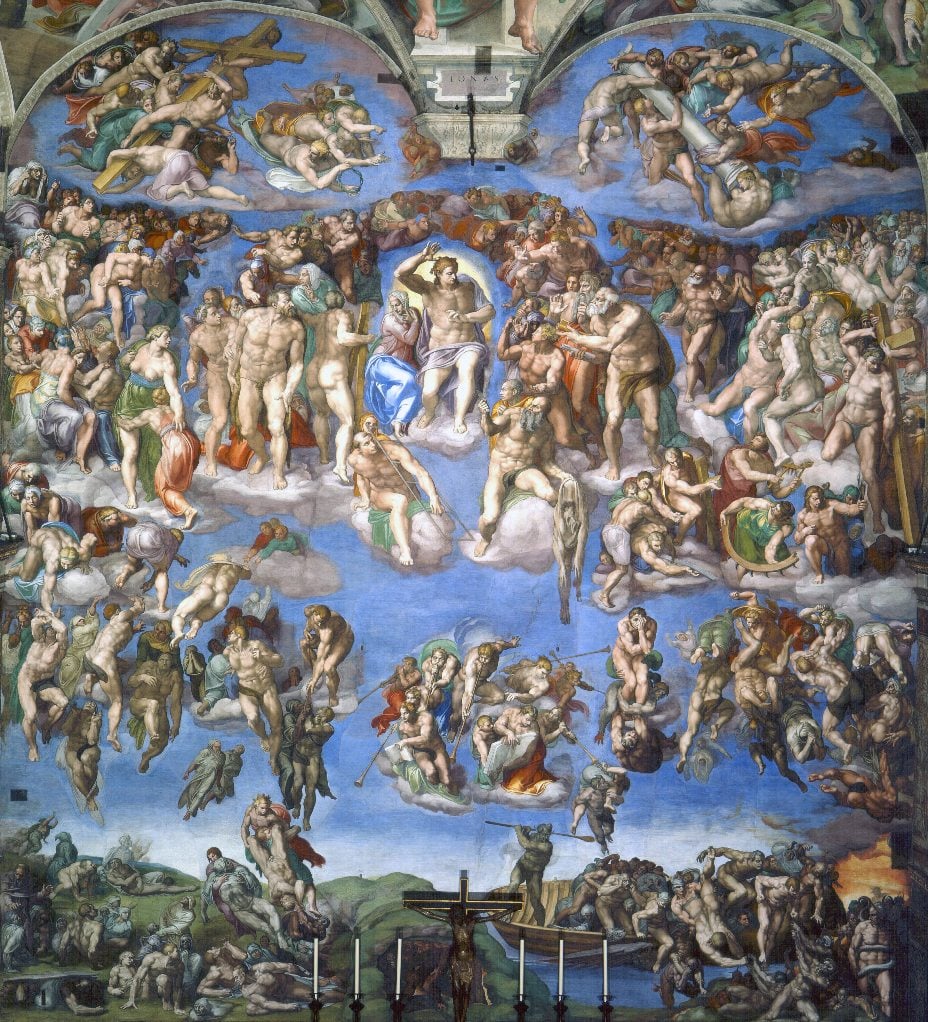
While every visitor who views the Universal Last Judgement in the Sistine Chapel assumes that Jesus is the center of the fresco painting will be surprised to learn that the true center is just below Jesus, where Saint Lawrence is depicted with his iron grill. A closer look will disclose that the martyr’s iron grill has no legs and it resembles a ladder more than a grill. It is Jacob’s ladder and the bottom rung of the ladder is the exact center of the largest fresco in the world which one will see the dynamic motion of the fresco revolves perfectly around the angle of the ladder. Thus, Michelangelo embedded the central teaching of Jewish mysticism in one of the most famous Catholic masterpieces of all time.
The Story of Moses
The South (left) wall tell the story of Moses from right to left, in Hebrew order:
Moses meets an angel; The Circumcision of the Second Born Child and Moses bids farewell to his father-in-law before setting out for Egypt. ( Pietro Perugino, 1466-1523 and Bernardino di Betto, known as Pinturicchio, 1454-1513).
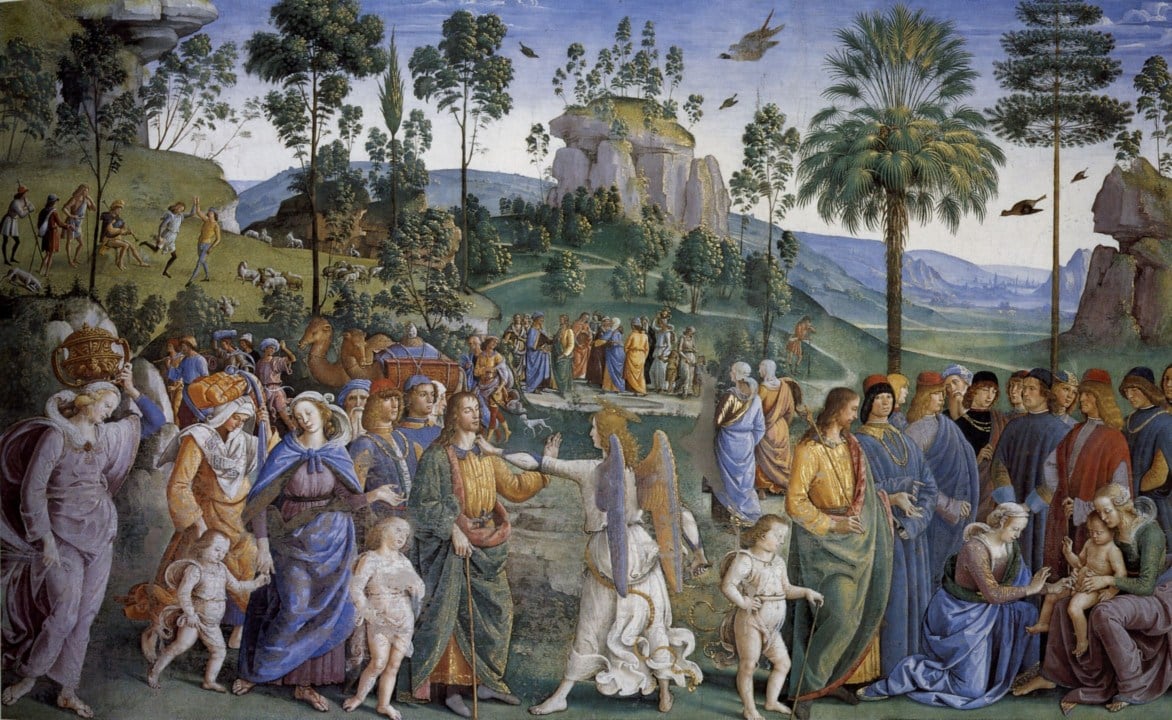
Seven episodes from the life of Moses – Moses kills an Egyptian and escapes to the land of Midian. Drives away the shepherds who are preventing the daughters of Jethro from drawing water. On Mount, Horeb Moses removes his sandals and receives his Mission from the burning bush and leads the Children of Israel from Egypt. (Sandro Botticelli, 1445-1510)
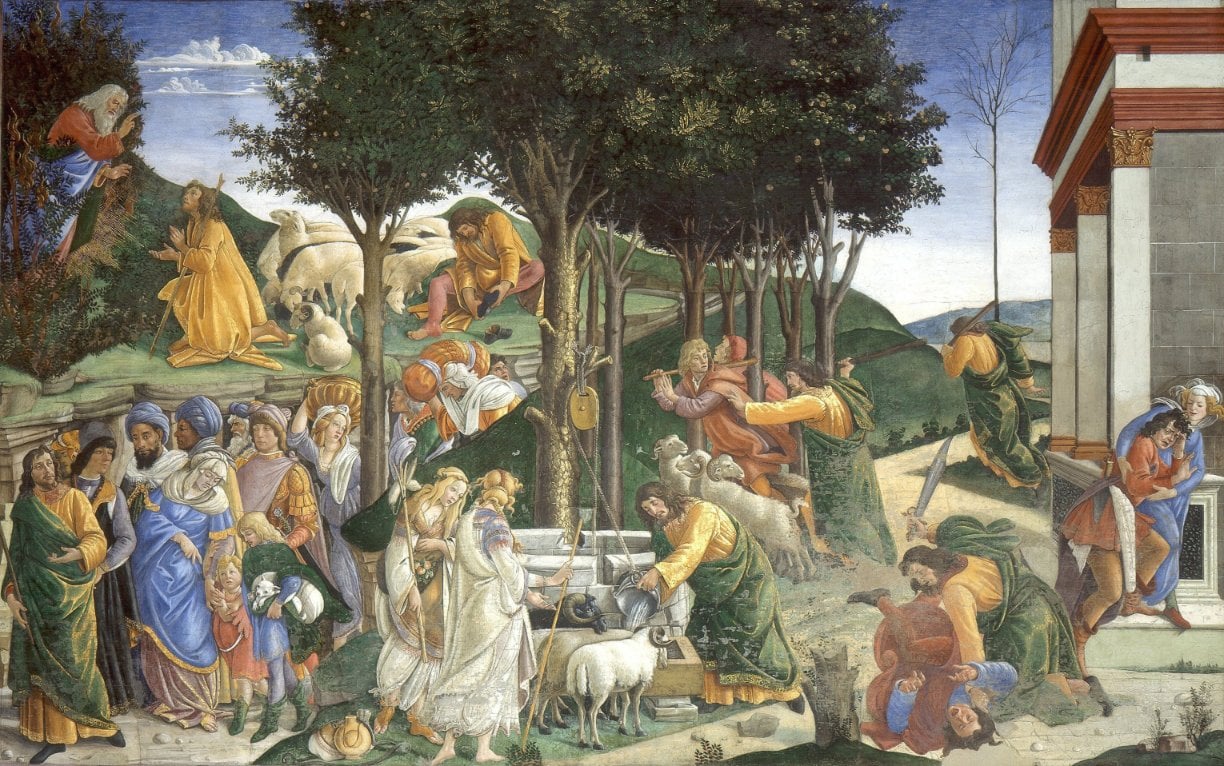
The Crossing from the Sea of Reeds ( The Crossing of the Red Sea, Cosimo Rosselli, 1439-1507). Moses led the people into a new wilderness.
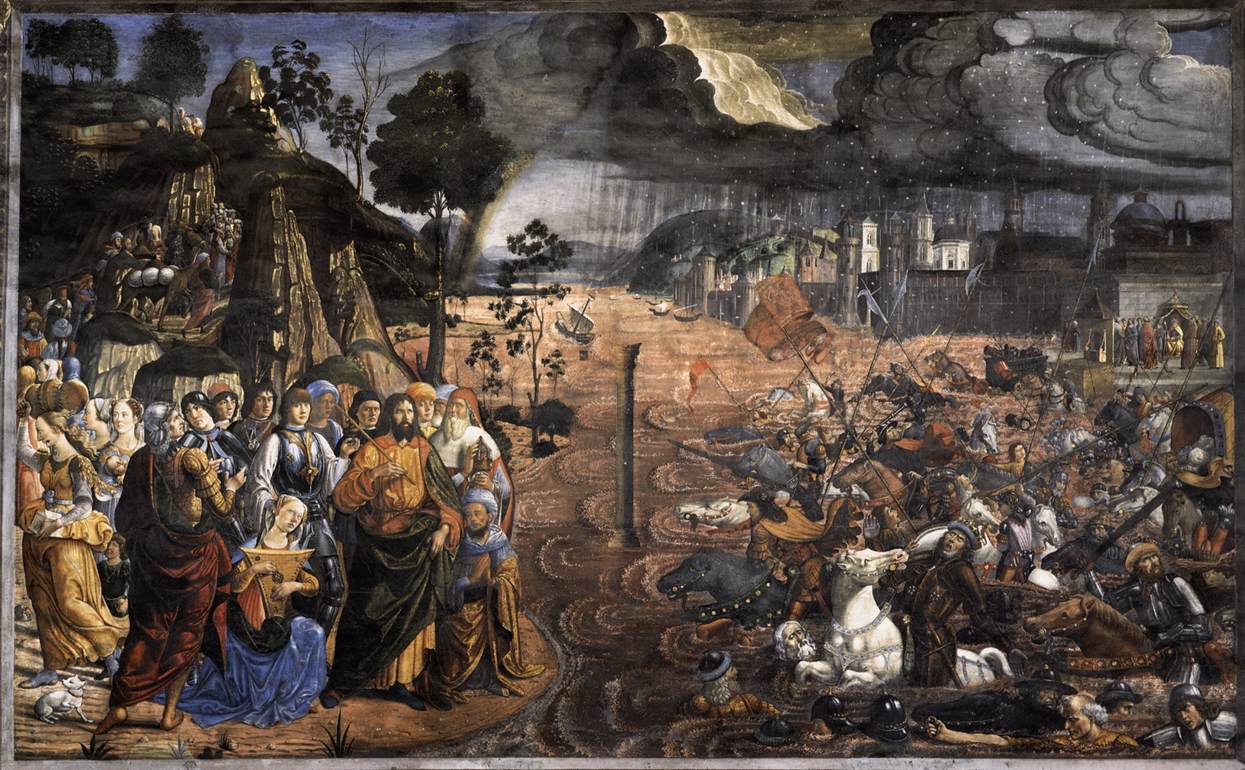
The Punishment of Korah, Dathan. and Abiram. Korah, Dathan, and Abiram deny the authority of Moses and Joshua, Korah is consumed by fire, Dathan and Abiram are swallowed up by the earth. (Sandro Botticelli, 1445-1510)
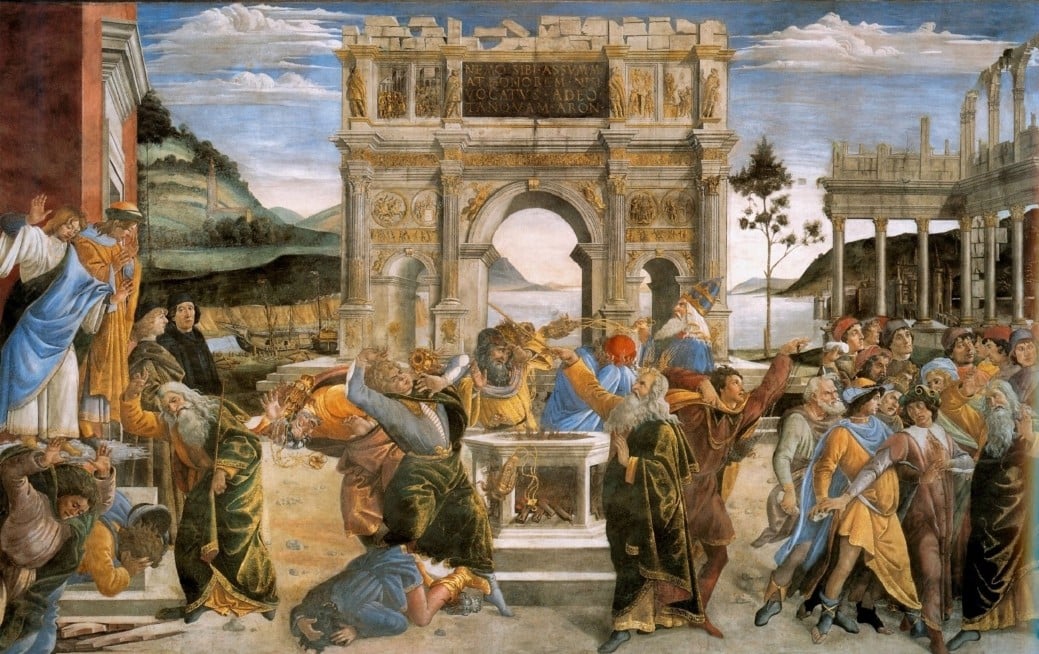
The Testament and Death of Moses -five episodes; in the foreground, Moses reads the testament and gives the Staff of command to Joshua. In the background an angel shows Canaan to Moses, Moses descends the mountain and prepares for death. Mourned by his family, he falls asleep on the ground. (Luca Signorelli, 1441-1523).
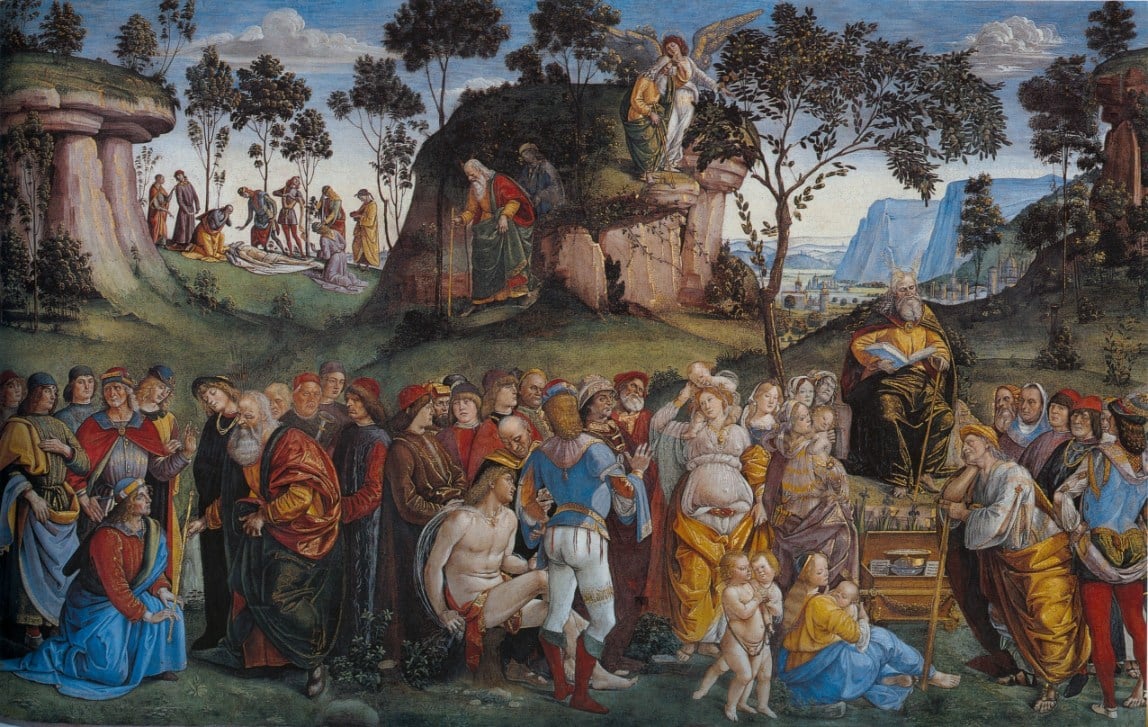
In Conclusion
The Torah (Jewish Bible) and the Old Testament are not the same things. The Old Testament is a Church-ordained re-editing of the original order of the Torah (Jewish Bible); it realigns the books of the major and minor prophets, and the Holy writings, to heighten the impression that the Hebrew Scriptures seem to be anticipating the coming of Christ. In addition, there are even many differences between the Catholic and Protestant versions of the Bible.
Brenda Lee Bohen
Brenda is a Latina and a proud Veteran of the United States Army Reserves. She holds dual citizenship in both the United States and Italy. She is a trained historic preservationist who tirelessly advocates the scholarship and history of the Jews of Rome. She has her certification in Jewish leadership and continues advanced studies at the Spertus Institute for Jewish Learning and Leadership. Brenda is also a licensed and accredited tour guide at the Jewish Museum of Rome and the Vatican Museums.
See more Blogs from Brenda: Jewish Rome, 3 Literary Treasures of the Jewish Museum of Rome
Sources
Rabbi Benjamin Blech and Roy Doliner “The Sistine Secrets”(Harper Collins 2008).
